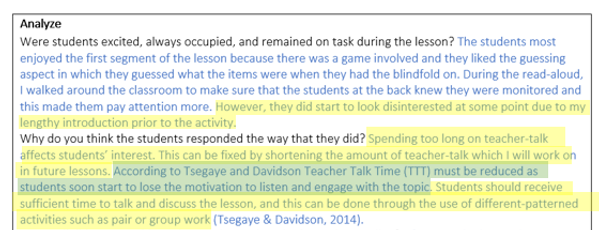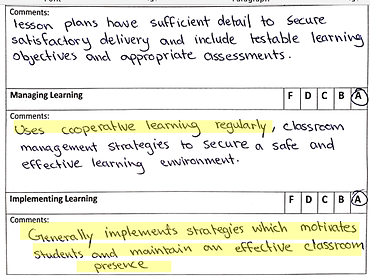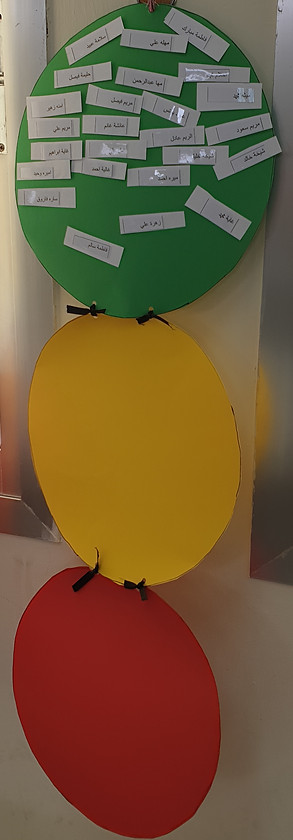Reflection on Practice
Page overview:
The following page is a display of my personal teaching strengths and weaknesses and ways in which I reflected on my work to implement the appropriate improvements.
Definition
Reflecting on practices involves the analysis of students' learning, a teacher's professional development, and using approaches that have been proven effective by research, all with the purpose of enhancing students' learning at the core (Nessipbayeva, 2012).
Levels of Reflection
Ward and McCotter (2004) set out levels of reflection, consisting of lower and higher levels of reflection, that depict the actions taken to reflect on teaching practices. The levels are: Routine, Technical, Dialogic, and Transformative (Ward & McCotter, 2004).
Self-reflections
Area for Development:
My Practices

In the beginning of the placement, I spent too much time on talking which I observed to have affected students' interest in the lesson.
Reflection
After researching online, I read that students must receive ample time to discuss the topic to stay engaged (Tsegaye & Davidson, 2014). This was something I implemented in the following lessons. Here, I demonstrated the dialogic level of reflection due to my focus on the process of learning (Ward & McCotter, 2004).
Mentoring School Teacher's (MST) Comment

I took my mentor's comments into account when planning for my next lessons by lessening the explanation time, and giving students more time to work on activities.
Improvements:
Students' Learning

During this lesson, I reflected on students' reaction to having the opportunity to converse with their peers in order to reinforce the information from the lesson before moving on to the main activity.
Reflection
Compared to the previous lessons, students were excited to share their knowledge with their partners during the pair work speaking activity. Furthermore, theorist Lev Vygotsky explained that when students put their thoughts into speech, new ideas are formed (Smagorinsky, 2007).
Click to find my other self-reflections:
Feedback Showing Improvements
Mentoring School Teacher (MST)
Mentoring College Teacher (MCT)

Students' motivation was seen to have risen after the implementation of cooperative learning, and pair work.
Trial and Error
Traffic Lights


I was able to confidently and consistently involve the use of cooperative learning during my lessons.
Positive Reinforcement

Rationale
The use of various structures for activities, such as group and pair work increased students' productivity. Each type of activity structure aims to achieve a different learning outcome in the classroom, and each are vital components (Bilash, 2009). Therefore, teachers must not depend only on individual work.
For the first two weeks of my teaching practice, I used the traffic lights strategy, in which students with good behavior are in the green circle, a warning puts them in the yellow circle, and the red indicates they must be punished. However, I found that the students who I was targeting with this strategy tend to misbehave more when their names are moved.
During the following week, I started using a reward system in which each student was given an envelope and when they do well, they receive play money. At the end of the week, students “buy” items depending on how much money they have collected. On the other hand, misbehaving would lead to the money being removed from their envelope, which is a form of negative punishment.
Rationale
A study by Madsen, Becker and Thomas (1968) showed that commanding students to stop unwanted behavior tends to increase that behavior. It is implied that placing less emphasis on bad behavior, while praising good behavior could bring more positive results (Madsen & Becker & Thomas, 1968). The switch between strategies was very insightful for me, as I noticed that the second one worked much better than the former one. My philosophy regarding teaching talks about the importance of planning, because doing research leads to the understanding of current effective strategies proven by research.
Reflection
This practice demonstrated the dialogic level of reflection due to my consideration of the students' perspectives toward the strategies, as well as conversing with other colleagues to make changes accordingly, leading to the improvement of the practice (Ward & McCotter, 2004).
Overall Reflection
Areas for Development
Mentoring School Teacher (MST)

Mentoring College Teacher (MCT)

My MST advised that I work on my classroom management strategies by being assertive in the classroom.
My MCT emphasized the need for sufficient modelling in the classroom to ensure that students know how to work on their activities. This comment also relates to my need to model new routines consistently, which is something I need to improve for one of my Professional Development Plan (PDP) goals.